Angela Shell has helped California sustain one of the best-performing and most innovative state procurement systems in the United States.
A Woman to Watch in Procurement

With nearly three decades of government service, California Department of General Services Chief Procurement Officer Angela Shell is a driving force for innovation, sustainable procurement practices and products, statewide training and policy, and systems modernization. She is a recognized advocate for small businesses and diversity, disabled veteran business enterprise programs, and expanding the scope of sustainability to include economic, social, and environmental impacts.
As a member of the board of directors for the Sustainable Purchasing Leadership Council, Shell champions the integration of sustainability into procurement processes. She also serves on the board of directors of the National Association of State Procurement Officials (NASPO).1
Shell has a track record of implementing best-in-class procurement practices resulting in significant savings for her state. Under her leadership, California has developed one of the best-performing state procurement systems in the country. Shell was recognized as a “Woman to Watch” in the procurement industry by DiversityPlus magazine.2
NCMA CEO Kraig Conrad, MBA, CAE, CTP, spoke with Shell in January 2023. They discussed contracting in a state as big as a country, challenge-based procurement, and the implementation of an Amazon-like marketplace for California state buyers.
Kraig Conrad (KC): Can you share your journey to becoming the procurement chief of one of the largest-spending governments in the world? What led you to state government contracting and procurement?
Angela Shell (AS): My government career spans more than 28 years. It shocks me when I say that because I remember becoming a state employee like it was yesterday. I started working with the Contractors State License Board in California, moved on to the Department of Insurance, and then the Department of Transportation (Caltrans). I was about four years into my state career at that time. It was there I found my interest in contract administration.
I was ensuring our state contractors were complying with various requirements of construction contracts. They included prevailing wage requirements in the state of California, the federal Davis-Bacon wage requirements, non-discrimination clauses, and prompt payment. The state has a disadvantaged business enterprise program related to federal transportation dollars. We also have our state small business and disabled veteran business enterprise requirements. I was learning all about Caltrans contracts and understanding the beginning of the process – how the contract was developed, advertised, awarded – and about all the specification and contract administration requirements.
It was very challenging work. I had not been in procurement or contracting before, and it pushed me to learn more about the entirety of the contracting process. I spent many years in our construction division in headquarters, graduating from lower-level administrative positions to leadership. Then I went to our Office of Business and Economic Opportunity.
After a few years, an opportunity opened as Caltrans chief of procurement. I went there to get in on the beginning stages of the Caltrans contracting process after so many years in contract administration. Eventually, the state procurement chief position came available. It wasn’t something that I immediately sought. I had been at Caltrans for 19 years, and the thought of leaving was scary. But I had a lot of support from my Caltrans peers. I knew I could use my experiences to make positive change at the statewide level, so I decided to take the position. The chief procurement officer is the highest contracting position within the state of California. It is as challenging, if not more, as all my other roles in procurement. I’m still learning, I’m still growing.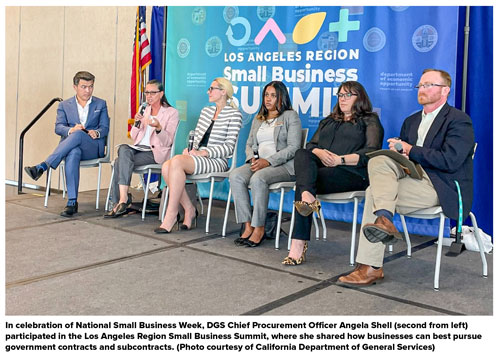
KC: California procurements are complicated and are funded by different levels of government. What compliance issues do you face with federal dollars?
AS: The federal government follows the Federal Acquisitions Regulation (FAR). In California, we have our own code of regulations. Federal requirements are similar. You must have competition. You must meet wage requirements for construction. There’s non-discrimination, there’s conflict of interest. Where we see differences, we have to consider both.
I’ll use my Caltrans experience on the federally funded construction contracts as an example.
As a contract administrator or as buyer, you have to make sure you’re considering both state and federal requirements in your contracts. That can be a challenge when it comes to procurement. We’ve seen it at the California Department of General Services (DGS) level. At my statewide level, we issue leveraged procurement agreements. These are agreements we put in place for all state departments to buy from.
We did a zero-emission bus procurement a few years back. The state was not buying off that contract, but our local transit authorities were. We knew the transit authorities would be reimbursed by the federal government under some of those programs. You might wonder why we had to factor in federal requirements on a statewide contract. At the end of the day, if the state wanted to get reimbursed, and we didn’t want to hamper our local entities, we had to be able to look at what the feds allow and require and how that interacts with our state contracting processes.
For example, we have a law in California that allows contracts to be wholly negotiated. The law is very broad. I can reach out directly to a vendor if it meets the needs of the state and bring it in under full negotiation. I don’t have to do competitive advertising or low bid. I can fully negotiate. The feds don’t have that capability in a lot of their programs. Those are things that you have to consider. When the federal government steps in, if it’s a transportation contract, you have the Disadvantaged Business Enterprise (DBE) program. We are not allowed to conflict with it because that federal regulation supersedes.
KC: You’re leading a challenge-based procurement approach. Can you explain it, and tell us how it is going?
AS: We have two types of challenge-based procurements in California. One is primarily used by our information technology department, and it is called challenge-based procurement. We also have, out of DGS, the Request for Innovative Ideas, or RFI2. It was issued as an executive order from our current governor in 2019. It’s also a type of a challenge-based procurement.
I think of challenge-based procurement as upending the normal process. You don’t go into a challenge-based procurement saying, “My problem is X and I need a specific good or service to solve it, here are all the requirements, tell me how much it’s going cost and what your schedule will be.”
Instead, we say, “We have a problem in the state of California, and we have not overcome it with a procurement solution in the past. So, industry, here is our problem.” They then tell us how they would solve this problem. It’s really a proposal-based process, and it’s done in phases. It’s a little more refined. You can say, “Look, here are our existing systems, we need to connect these two, and we don’t have a good idea of how to do that."
We have more information on the RFI2 side. For example, a little over a year ago, there was an RFI to try to secure a single test for COVID-19 and the flu, and Respiratory Syncytial Virus (RSV). We knew that such a test didn’t necessarily exist. We also didn’t know how it could be done correctly or who was leading the effort in industry. We threw these factors out there as an RFI2 to the pharmaceutical world. As it turns out, it wasn’t possible at the time. I see that as a success because we put it out there, and no one was able to give us a solid solution as to how they could accomplish that.
In the normal procurement world, you would have issued a procurement and received responses indicating it may or may not work. You would’ve wasted all that time. Whereas in this example, we were able to step in and conclude that the industry needs to evolve.
Our very first RFI2 was a fire-based solution. We wanted to get early detection and then know the direction of the fire to get ahead of it. This was in response to the terrible Camp fire in 2018, in which more than 80 lives were lost. We worked with the state CalFIRE department as well as the Technology Department to identify what the procurement would look like. CalFIRE talked to academia, universities, and international entities to see how it’s done in other countries. CalFIRE also talked to local fire officials and sheriffs to really have a basis before they sent out a problem statement. One might argue that’s the request for information process but done during the procurement instead of prior to it.
The problem statement was really succinct because of whom CalFIRE talked to and what it wanted to know from the industry. Proposals came in following a set criterion. It became more like a request for proposal (RFP) process. The proposals are scored and a pool of proposers is established. In Phase 2, proposers are chosen to demonstrate their solutions, depending on the criteria, which vary, and a final solution is chosen.
The fire solution went out in March and had to be ready by November. CalFIRE got a chance to test it under a multi-phased testing contract. If the budget is there, in some cases we’ll pay for development of the solution. This is not something you see in a traditional procurement. Then, the solution has to be able to scale statewide.
We’ve had feedback indicating IT vendors don’t know just yet whether they like the challenge-based process. They’ve shared that they feel these opportunities can be geared for those that already work with the state on major systems. The feeling is that incumbents still are going to win because they have inside knowledge that newcomers don’t.
Others say this is a great opportunity for partnership between a large business and a small business because we have a very robust small business program. We are encouraging partnership to help small businesses participate. We also are making sure we’re being transparent so industry knows exactly how we’re scoring these procurements.
We’re tracking the success. We do evaluate whether a procurement is a good fit for challenge-based or an RFI2. Often, a department will come to us and say, “This is what we want and we want it this way, and we want you to do an RFI2.” It’s because RFI2 was initially presented as a fast way to do a procurement. It really isn’t. It changes the way the procurement process works to help generate solutions that we may not have considered.
You spend a lot of time evaluating problem statements to determine whether they are going to cover what is needed. I don’t think we would say this is going to be our norm. We’re still looking each time to see if a requirement is a candidate, and if not, then we’re going to go to another process.
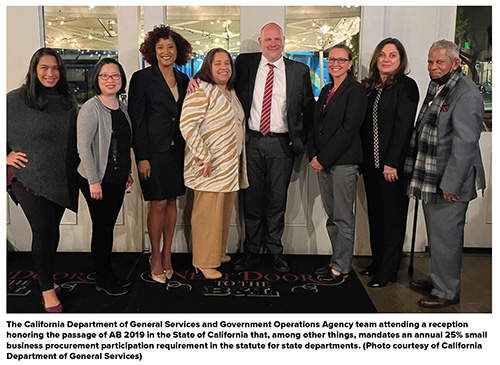
KC: You mentioned the concerns of your industry partners. We’re experiencing that now with federal-level sustainable procurement. We’re seeing a little bit of hesitancy, a little bit of resistance. California is further ahead than the federal government. How are you doing in that effort? How is it being received by vendors and the agencies?
AS: We’ve had an environmentally preferable purchasing (EPP) statute in the books since the early 2000s. We’ve had a well-defined process in place for goods. We develop green specifications that we put in our contracts. For example, if we’re buying computers and monitors, we want Electronic Product Environmental Assessment Tool (EPEAT) third-party certification at a Silver or Gold level.3 We include those types of requirements in our contracts regularly. Our state departments are very familiar with them.
Green specifications go into as many state leveraged procurement agreements as possible. If a state is buying from my contract, it has already been taken care of by my buyers. We also encourage them to include these green specifications when they’re issuing solicitations for their own contracts. They can come to my procurement engineering team and ask them to develop a green specification for a specific product they want to procure. It’s in our state contracting manual, which is our guidance for all state departments that buy.
We also have the State Agency Buy Recycled Campaign (SABRC). It is specific to recycled content and required on every contract. If a vendor is supplying something, even if we don’t have a green specification, we have SABRC. We want to know what your recycled content is for any goods that you’re supplying. If it’s something specific like tires, recycled paint, or other goods that are in our statute, we want to know if it meets the required minimum recycled content. Frankly, we don’t get a lot of pushback because SABRC has been around for a very long time.
Now, we’re striving for a more holistic view of sustainability. The EPP law includes greenhouse gases, water usage, etc. Now we are looking at the social and economic pieces of sustainability. We are starting to consider whether we are increasing participation of our certified and diverse firms. How diverse is our contractor pool? How are our vendors increasing their diversity? We’re anticipating being able to set benchmarks or targets in those specific areas at some point. Soon we will publish a report providing a snapshot of what California is doing with respect to sustainability in procurement.
The other big piece is our Buy Clean California Act (BCCA). It’s something that I think the feds have been looking at for some time as have other states. The BCCA is first-in-the-nation legislation that came about in 2017. It was fully implemented July 1, 2022. The BCCA requires environmental product declarations (EPDs) for eligible materials or products including structural steel, concrete reinforcing steel, flat glass, and mineral wool board insulation.
Now with our EPDs, we are collecting data on global warming potential. We are putting that in a report to our legislature to inform it of what’s happening in the BCCA’s first year. Since it doesn’t cover all construction materials, it doesn’t apply to a lot of the volume of state contracts.
There’s been a lot of outreach to our contractors, and there was a lot of pushback initially. It wasn’t just a policy decision. That statute was put in place, and it wasn’t an option for us to not move forward. I think industry understood that. I think it would rather be in the boat than out of the boat and not be able to participate in a contract in the state because it didn’t step up. I think it’s had the positive impact of making industry aware and driving it forward in some ways. We’re excited to see where this goes in the first year and what our challenges are for full implementation.
KC: The vendor community is looking for clarity at the federal level, so, we look forward to learning more about how California is moving forward.
In 2021, you started your journey to build an Amazon-like marketplace catalog. Can you share where you are with that project? How would the marketplace work? How is it fair from the perspective of small and disadvantaged businesses?
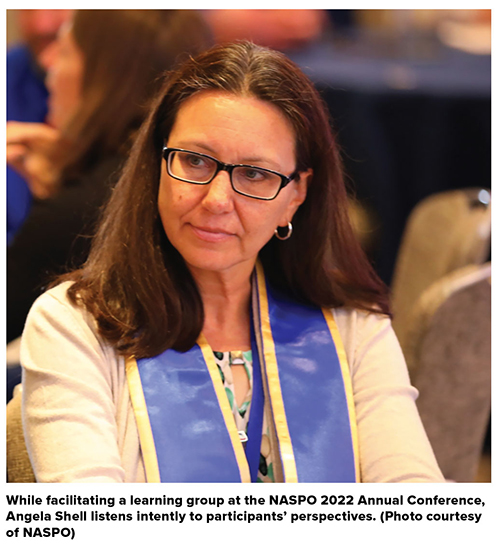 AS: This is a great project for us. We’ve worked through our business requirements for our vision of an e-marketplace cataloging system. We’re awaiting funding to move to our next phase, which would be the procurement phase. That is followed by implementation, maintenance, and operations. This is a long-term goal as it will take us a few years to realize a full implementation.
AS: This is a great project for us. We’ve worked through our business requirements for our vision of an e-marketplace cataloging system. We’re awaiting funding to move to our next phase, which would be the procurement phase. That is followed by implementation, maintenance, and operations. This is a long-term goal as it will take us a few years to realize a full implementation.
It would be great to have an Amazon-like marketplace to catalog and look at what we have on contract.
Our first step is getting all our leveraged procurement agreements on this system. Then buyers can go in, see what’s there, click on what they want to buy, and also have the sustainability attributes of those goods or service.
The goal is to be able to leave our system, enter the e-marketplace, get everything you need, return to the system, and process your procurement. We have small businesses and disabled veteran business enterprises on contracts already. They would automatically be loaded up. The future of that system would be to have our universe of California-certified small businesses also upload their catalogs into the system. That will take time because we have roughly 18,000 certified businesses.
We also are very aware of the concern for small businesses and mom-and-pop shops that might not have access to put a catalog on the internet. That can be a barrier, and we’re working through that now.
We’re considering how much time the process saves our buyers while giving them an opportunity to submit with a few clicks, rather than entering data, and importing that into the system. It initially started when we had buyers purchasing from Amazon. We don’t necessarily encourage that, and we don’t allow it for mandatory contracts. But if you can’t get something, there are times when you have to choose other options.
Right now, the spending is relatively low considering the size of the entire state’s spending. We will be putting controls in place to make sure that we’re not buying things off the system that are not approved on contract. But I think it’s been very much supported by our buying community and the vendor community. It’s an exciting time for us.
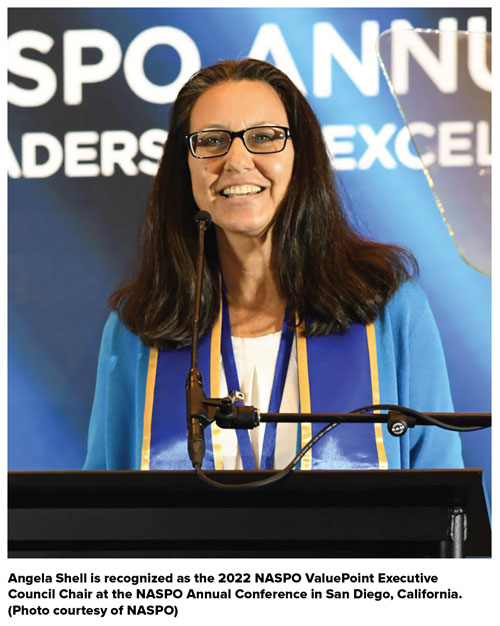 KC: You serve on the board of directors for the National Association of State Procurement Officials (NASPO). We have been collaborating with NASPO on the Contract Management Organizational Capability (CMOC) program supporting state officials. Tell us about your experiences with NASPO and how you see our organizations coming together to help elevate and grow our profession.
KC: You serve on the board of directors for the National Association of State Procurement Officials (NASPO). We have been collaborating with NASPO on the Contract Management Organizational Capability (CMOC) program supporting state officials. Tell us about your experiences with NASPO and how you see our organizations coming together to help elevate and grow our profession.
AS: I’ve been participating in NASPO since I came to the Department of General Services in early 2018. California already had a role in the NASPO Value Point organization, which was a separate entity within NASPO.4 California has a long history of participating with NASPO, and I think it really brings value to the national level because we’re so large. We might not always need to use the cooperative contract put in place by lead states working with NASPO because we can do our own contract and perhaps get better pricing or quantity simply due to our state’s volume. But that said, the NASPO contracts provide us with great options when our contracts don’t have the same products, or we need an expedited procurement option for state buyers. These contracts also allow our local government entities the ability to purchase off a contract without having to go through a lengthy process on their own.
The value of participating in this national organization is the benefit of hearing from your peers and recognizing that you have the same challenges everybody else does. The challenges facing someone in a smaller state are not going to be any different. That was humbling for me when I first discovered NASPO, and it has helped me be a better procurement official knowing we are all together in our experiences.
I cannot say enough about partnering with your peers in a national organization. The NCMA-NASPO partnership and collaboration will help state departments grow in their training. I’m really excited about this contract management element.
You can have a great contract, and a great award, and the best vendor. But if you don’t have good contract administration, everything you did is for naught. You might get a contract but fail in contract administration because you’re missing key elements, or the state department isn’t helping. That’s where I see the value in collaboration with your organization. Partnerships bring another element into the procurement world. I think sometimes people forget that the contract administration piece is equally as important as getting a good contract executed. This is where the good or service is provided and no matter how solid the contract is, if you don’t make sure the good or service is supplied or performed to the requirements of the contract, the state is left with an undesirable end result.
My experiences with NASPO have been fantastic. I was the chair of the Executive Council, which is on the Value Point side, and I’ll be on the board for the next two years. Again, that gives California a great opportunity to get insight into the organization an d help it
shape the future with the strategic plan.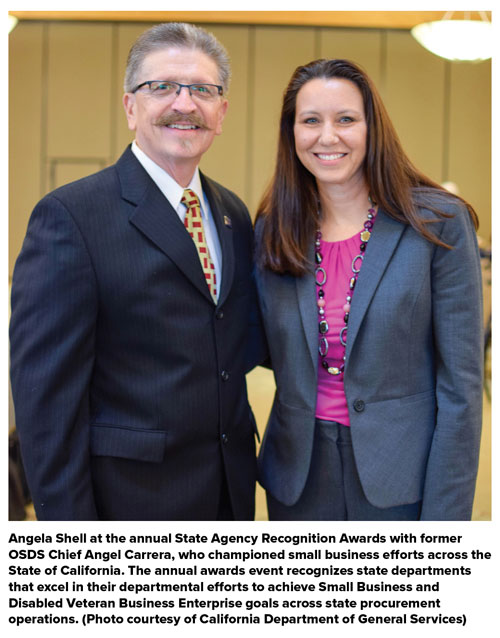
KC: I would be remiss if didn’t ask about market research, which is the theme of this issue of Contract Management. How does market
research happen at the state level? How do you engage buyers to ensure that they’re aware of what the market can do?
AS: We do market research every time we put out a contract. This has been especially important in the last few years with ongoing vehicle contracts and personal protective equipment contracts we put in place during the pandemic. We’ve started using some of the tools that NASPO offers. It puts together reports on where some of the major industries are heading and what the market looks like. We’ve started sharing that information with our state departments. For example, if they put a contract in place for cell phones, we can give them insight on projected prices or delays.
On our own contracts, we work regularly with our departments. For example, we talk to them about delays in procuring vehicles. You need to be able to balance your requirements within your department, understanding that you may not have vehicles. Maybe you were expecting to get them in three months, and now you may not get them in six months.
Pricing increases run across nearly every food-related contract. We buy a lot of food for our prisons and state hospitals. We’ve built in price increases, and we’re having regular conversations about when there will be an increase. We had one with beans – massive winter storms across the nation caused a bean shortage.
What do we do about that? We try to use these reports, do our market research, and talk to other states. We send that information out in our regular forums with our state departments and then individually with them as needs come up. We also do market research with industries through RFIs, and we ask questions such as, “How’s it looking in your industry?,” “Are there new products coming up?,” and “How significantly backlogged are you?”
Our industries are pretty good at leveling with us about what’s happening. That doesn’t mean we don’t negotiate, and we try to gauge the market. In the example I previously gave of the bus procurement, we really had to do our research to find out who’s in this industry. We were looking at sample buses and bringing them into our department to see them up close. We weren’t experts in that space, but we were able to approach it from the perspective of statewide quantity, price, etc.
I would really love to see my contract administrators do even more to make sure they’ve got a good connection with their vendors and those industries that know what is going to happen before it happens.
KC: Members of our profession can be powerful solution partners when they understand market and industry capabilities, and what’s coming next from a market intelligence perspective.
Wrapping up, we’d like to hear your advice for younger professionals about building a career in contracting and procurement. Are there things that you have learned that you wish you could go back and tell your younger self? Any wisdom you would like to share?
AS: When I started working at Caltrans and discovered contract management, I found something I was passionate about. My best advice would be to focus on the impact you’re having on communities. Government jobs can be very rewarding.
I think you really have to find your passion. Look at the rewards. How are you affecting your state or federal operations?
Keep learning – I always wanted to know more. I learned what I was doing, then I went for the outer circles of knowledge, and I just kept learning. Ultimately that’s what drove me to leadership, and then executive management, and to where I am today. As I start thinking about when retirement may be an option, I look at the span of my career, and it’s been very rewarding.
Government has a unique impact that people don’t realize. On the emergency procurement side, to know you’re helping a family or buying products that are saving lives is powerful; knowing you are buying goods and services that can help people challenged with homelessness or assisting with access to transit. As challenging and grueling as it can be, that is where you find the reward. That’s what I would tell younger professionals. We’re unable to attract a lot of people because we’re not describing what the job entails in recruiting. Younger professionals need to know they’re having an impact on the world. We need to help them understand the value of what they’re doing. CM
ENDNOTES
1 NCMA and NASPO have partnered to create the Contract Management Organizational Capability (CMOC) program for state procurement offices seeking to establish training programs for contract management staff, https://www.ncmahq.org/Shared_Content/Press-Release/NCMA%20and%20NASPO.aspx?WebsiteKey=b1a73ade-fc1d-414a-a6b5-f8223a0c420b
2 https://diversityplus.com/web/Article?type=article&id=Going-All-In-Digital-Transformation-of-Procurement-for-New-Value-Generation-5238
3 EPEAT (Electronic Product Environmental Assessment Tool) is a ranking system that helps buyers choose desktop computers, notebooks and monitors based on their effect on the environment. EPEAT ranks products on performance on 51 criteria into three tiers – Bronze, Silver and Gold. The Green Electronics Council manages EPEAT, https://www.epeat.net/
4 NASPO ValuePoint is a non-profit cooperative contracting arm of NASPO, facilitating administration of the NASPO cooperative group contracting consortium of state Chief Procurement Officials.